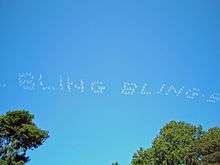Skywriting

Skywriting is the process of using a small aircraft, able to expel special smoke during flight, to fly in certain patterns that create writing readable by someone on the ground. The message is often a frivolous phrase, a generally meaningless greeting, or an advertisement aimed at everyone in the vicinity, a general public display of celebration or goodwill, or a personal message, such as a marriage proposal or birthday wish.
Description
The typical smoke generator consists of a pressurized container holding a low viscosity oil, such as Chevron/Texaco "Canopus 13", formerly "Corvus Oil". The oil is injected into the hot exhaust manifold, causing it to vaporize into a huge volume of dense, white smoke.
Wake turbulence and wind cause dispersal and shearing of the smoke causing the writing to blur and twist, usually within a few minutes. However special "skytyping" techniques have been developed to write in the sky in a dot-matrix fashion (a new letter every 2–5 seconds instead of every 1–2 minutes), and are legible for longer than traditional skywriting.
History
The beginnings of skywriting are disputed. In a 1926 letter to The New York Times, Albert T. Reid wrote:
- A newspaper paragraph says skywriting was perfected in England in 1919 and used in the United States the next year. But Art Smith, who succeeded Beachey in flying exhibitions at the Panama–Pacific International Exposition in San Francisco in 1915, after the latter had been killed, did skywriting, always ending his breathtaking stunts by writing "Good night." This was not a trial exhibition, but a part of every flight, and was always witnessed by thousands.[1]
Major Jack Savage, former British Royal Air Force pilot and a writer for Flight magazine, had a successful skywriting fleet of Royal Aircraft Factory S.E.5 aircraft in England. He flew throughout the 1920s and 1930s, bringing the practice to America as well.[2][3] The first recorded use of skywriting for advertising purposes was at the Derby at Epsom Downs, in the U.K., in May 1922, when Captain Cyril Turner wrote "Daily Mail" above the track.[4] In the U.S.A. this was on November 28, 1922 over New York City during a visit of Savage and Cyril Turner.[5][6][7]
However, commercial skywriting in the United States was developed in the early 1930s by Sid Pike, founder of the Skywriting Corporation of America in 1932. One of the first major clients was Pepsi-Cola, which used skywriting to reach a mass market. A tremendous number of flights were contracted by Pepsi-Cola, with 2,225 flown in 1940.[8] Skywriting has also been used at times by artists. Skywriter Wayne Mansfield flew for John Lennon and Yoko Ono, and he appeared as a sky artist over the Biennale in Venice, Italy. Artist Vik Muniz used skywriting for his "cloud cloud" project.
Skytyping
In 1946 the Skywriting Corporation found themselves with a fleet of surplus World War II planes and developed "dot matrix skywriting", or skytyping.[9] Skytyping is the process of using five planes in formation to choreograph puffs of smoke being released from each plane. The messages, written at 10,000 foot altitude, can be up to 1250 feet tall and over five miles long. Traditional skywriting letters are 3,000 feet high and take longer to write.
See also
References
- ↑ "Skywriting in 1915," The New York Times, October 9th, 1926, p. 16
- ↑ Air Trails: 48. Winter 1971. Missing or empty
|title=(help) - ↑ obituary Flight 1945
- ↑ "S. Sidney Pike Skywriting Corporation of America Collection 1920s-1940s". Smithsonian. National Air and Space Museum. Retrieved 2015-08-29.
- ↑ Harriet Veitch (2006-12-02). "How big are skywriting letters?". Sydney Morning Herald. Retrieved 2008-09-17.
- ↑ "November 28, 1922: First Skywriting Ad over New York's Times Square". Retrieved 2015-08-29.
- ↑ "Repeat his "Sky Writing"". New York Times. 2015-11-22. Retrieved 2015-08-30.
- ↑ "S. Sidney Pike Skywriting Corporation of America Collection 1920s-1940s". Smithsonian. National Air and Space Museum. Retrieved 17 April 2014.
- ↑ Cecil Coffrin, Pepsi Skywriting pilot
External links
| Wikimedia Commons has media related to Skywriting. |
http://www.geoengineeringwatch.org/

